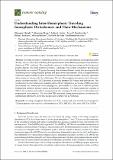| dc.contributor.author | Jonah, Olusegun F. | |
| dc.contributor.author | Zhang, Shun-Rong | |
| dc.contributor.author | Coster, Anthea J | |
| dc.contributor.author | Goncharenko, Larisa | |
| dc.contributor.author | Erickson, Philip J | |
| dc.contributor.author | Rideout, William C | |
| dc.contributor.author | de Paula, Eurico R. | |
| dc.contributor.author | de Jesus, Rodolfo | |
| dc.date.accessioned | 2020-05-27T18:57:30Z | |
| dc.date.available | 2020-05-27T18:57:30Z | |
| dc.date.issued | 2020-01-09 | |
| dc.date.submitted | 2019-11 | |
| dc.identifier.issn | 2072-4292 | |
| dc.identifier.uri | https://hdl.handle.net/1721.1/125515 | |
| dc.description.abstract | Traveling ionospheric disturbances (TIDs) are wave-like disturbances in ionospheric plasma density. They are often observed during both quiet (medium-scale TID) and geomagnetically disturbed (large-scale TID) conditions. Their amplitudes can reach double-digit percentages of the background plasma density, and their existence presents a challenge for accurate ionosphere specification. In this study, we examine TID properties using observations obtained during two geomagnetically disturbed periods using multiple ground and space-borne instruments, such as magnetometers, Global Navigation Satellite System (GNSS) receivers, and the SWARM satellite. Reference quiet time observations are also provided for both storms. We use a thermosphere-ionosphere-electrodynamics general circulation model (TIEGCM) results to properly interpret TID features and their drivers. This combination of observations and modeling allows the investigation of variations of TID generation mechanisms and subsequent wave propagation, particularly as a function of different plasma background densities during various geophysical conditions. The trans-equatorial coupling of TIDs in the northern and southern hemispheres is also investigated with respect to attenuation and propagation characteristics. We show that TID properties during trans-equatorial events may be substantially affected by storm time background neutral wind perturbation. Keywords: traveling ionospheric disturbances (TIDs); background neutral wind; interhemispheric TID propagation; trans-equatorial characteristics of TIDs; TIEGCM; O/N2 ratio; MSTIDs; LSTIDs | en_US |
| dc.description.sponsorship | US National Science Foundation (grant no. AGS-1242204) | en_US |
| dc.description.sponsorship | NASA LWS (grant no. NNX15AB83G) | en_US |
| dc.description.sponsorship | AFOSR MURI (grant no. FA9559-16-1-0364) | en_US |
| dc.description.sponsorship | ONR (grant no. N00014-17-1-2186) | en_US |
| dc.publisher | Multidisciplinary Digital Publishing Institute | en_US |
| dc.relation.isversionof | 10.3390/rs12020228 | en_US |
| dc.rights | Creative Commons Attribution | en_US |
| dc.rights.uri | https://creativecommons.org/licenses/by/4.0/ | en_US |
| dc.source | Multidisciplinary Digital Publishing Institute | en_US |
| dc.title | Understanding inter-hemispheric traveling ionospheric disturbances and their mechanisms | en_US |
| dc.type | Article | en_US |
| dc.identifier.citation | Jonah, Olusegun F., et al., "Understanding inter-hemispheric traveling ionospheric disturbances and their mechanisms." Remote Sensing 12, 2 (Jan. 2020): no. 228 doi 10.3390/rs12020228 ©2020 Author(s) | en_US |
| dc.contributor.department | Haystack Observatory | en_US |
| dc.relation.journal | Remote Sensing | en_US |
| dc.eprint.version | Final published version | en_US |
| dc.type.uri | http://purl.org/eprint/type/JournalArticle | en_US |
| eprint.status | http://purl.org/eprint/status/PeerReviewed | en_US |
| dc.date.updated | 2020-03-02T13:01:01Z | |
| dspace.date.submission | 2020-03-02T13:01:01Z | |
| mit.journal.volume | 12 | en_US |
| mit.journal.issue | 2 | en_US |
| mit.license | PUBLISHER_CC | |
| mit.metadata.status | Complete | |
